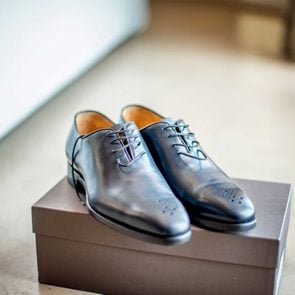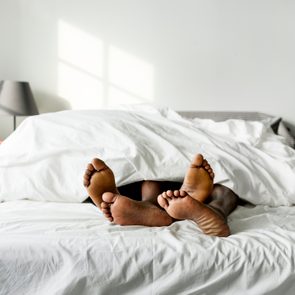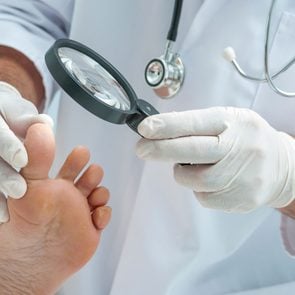9 Best Shoes for Heel Pain, According to Podiatrists
Updated: Apr. 23, 2021
A supportive pair of shoes with arch support, cushioning, and stability can make a big difference when it comes to heel pain.
Our editors and experts handpick every product we feature. We may earn a commission from your purchases.
On This Page
What causes heel pain?
Just like many other types of foot pain, there are a handful of things that can cause heel pain in particular—and having the right shoe can do a lot to ease that pain or prevent it in the first place.
Think about it: Your heel hits the ground with a decent amount of force on every step you take. There’s a lot that can go wrong and leave your heels feeling achy, from simple overuse and inflammation to an actual bone fracture.
There are several common conditions that cause pain in both the bottom and back of the heel.
Plantar fasciitis
Plantar fasciitis is a painful condition caused by inflammation of the connective tissue, or fascia, that runs along the bottom of the foot from the heel to the base of the toes.
It’s the most common cause of heel pain, says Paul Langer, DPM, a sports medicine podiatrist and at Twin Cities Orthopedics in Minneapolis and Superfeet Wellness Expert.
The pain usually is on the bottom of the heel, and often hurts the most first thing in the morning, says Houman Danesh, MD, director of integrative pain management for Mount Sinai Hospital in New York City.
Too much running, jumping, or any other repetitive activity, especially on hard and unforgiving surfaces, can cause the plantar fascia to become inflamed and painful.
Certain muscle weaknesses in the butt, hips, or legs, or poor form that throws off proper foot alignment, can also lead to the painful condition, Dr. Danesh says. Even poor foot and ankle flexibility can contribute to plantar fasciitis.
Treatment involves taking time off the activity that caused the problem in the first place, doing special foot exercises, taking nonsteroidal anti-inflammatory medications (NSAIDs) to reduce swelling, wearing a heel pad in shoes, and switching to more supportive shoes.
If the cause is an imbalance or tightness, you’ll need to do exercises to correct the issue in order to prevent it from striking again.
Bone spur
Repeated strain on the bottom of the foot can also lead to bone spurs in the bottom of the heel. Bone spurs are bone growths, or calcium deposits, that protrude from the foot.
Heel spurs may also pop up alongside plantar fasciitis, forming where the fascia connects to the heel bone.
Similarly, muscle imbalances and bad shoes that throw off your walking biomechanics can also contribute to bone spur formation over time. Bone spurs also commonly form as a result of osteoarthritis in a specific joint.
Heel spurs are typically treated the same way as plantar fasciitis: rest, exercises, NSAIDs, heel pads, and better shoes.
Bursitis
Bursitis is a condition that happens when the bursae, fluid-filled sacs that cushion bones and soft tissue, become inflamed. This typically happens in the back of the heel where the Achilles tendon connects the calf to the heel bone.
The Achilles tendon is the largest tendon in the body, which runs down the back of your calf.
If a muscle imbalance or repetitive activity puts a lot of pressure on the ankle and tugs on the tendon, over time, the bursae can become inflamed, Dr. Danesh says. The pain may feel more intense when you bend your ankle upward or stand on your tiptoes.
Treatment is similar to plantar fasciitis: rest, NSAIDs, physical therapy, and supportive shoes. Ice and over-the-counter heel wedges can also help—the latter decreases some stress on the heel.
If conservative treatments don’t help, your doctor may use corticosteroid injections.
Tendonitis
If the back of your heel hurts, you could be dealing with Achilles tendonitis. This common condition happens when the Achilles tendon becomes inflamed. Since it connects your calf muscles to your heel bone, you use it constantly every day to walk, run, climb stairs, even stand on your tiptoes to reach something off a high shelf.
Lots of repetitive use (especially if your ankle or calves are really tight) can inflame the tendon and cause swelling, pain, stiffness, and irritation. This overuse injury can also cause tiny tears in the tendon, and may even lead to bone spurs if the damaged fibers harden over time.
Rest, ice, NSAIDs, calf stretches, supportive shoes, and orthotics that lift the heels to take the pressure off the tendon are the first treatments your doctor will suggest.
If those don’t help, they may recommend a walking boot for a short period of time, and maybe surgery if the pain doesn’t improve after six months.
Bruise
Your heel pain could also be caused by something simpler: a run-of-the-mill bruise. If you step on something hard, like a stone, it can bruise the fat pad on the bottom of the heel, causing tenderness and pain when you walk.
As long as nothing is broken or torn or otherwise damaged, and it’s truly just a bruise, simply resting should make the pain go away. It may take a few weeks, depending on how deep the bruise is.
Calcaneus fracture
A fracture in the heel bone can be really painful and disabling, and recovery is typically long and may require surgical intervention.
Luckily, heel fractures are not common outside of a traumatic event—like a car crash or falling from a ladder or other accident that causes so much pressure that the bone actually breaks.
So you probably don’t need to worry that your heel pain is a fracture unless you can pinpoint a certain moment in time that you injured your foot.
How to choose the best shoes for heel pain
No matter what’s causing your heel pain, switching to better shoes is always a good idea.
Ideally, shoes should have a combination of support and cushioning, Dr. Langer says.
“Cushioning is important for comfort but the ideal amount is different from person to person and while it may sound counterintuitive cushioning is rarely, by itself, the most important factor in preventing or relieving heel pain.”
Here are the best features to look for in shoes to help improve heel pain.
Cushioning
Cushioning, especially in the heel area, adds extra shock absorption and reduces the amount of pressure coming up into your feet when they hit the ground, says Laura R Lefkowitz, DPM, attending in the Division of Podiatric Surgery at Cedars Sinai Medical Center.
“This is especially helpful with a high-arched or rigid type foot.”
Arch support
“There are studies that show that supporting the arch can reduce plantar heel pressure and also relieve strain on the plantar fascia,” says Dr. Langer. Arch support also helps prevent the arch from collapsing inward too much when you walk, a phenomenon called overpronation. (This can also contribute to bunions.)
The right arch support for your foot type is important, too. “Good arch support, and a shoe designed specifically for a pronator (flat arch), supinator (high arch), or neutral foot type is desirable,” Dr. Lefkowitz says.
“These will have a specific angulation built into the shoe in order to compensate for any abnormal foot function. This will, in turn, give relief of heel pain by supporting the plantar fascia and relieving the abnormal stretch and strain on the thick plantar fascia that runs from the heel bone to the ball of the foot.”
Stability features
“Stability features such as medial posts, dual-density midsoles, or shanks may be important for some people but not all,” Dr. Langer says.
If your shoes don’t end up being stable enough for your feet, adding a shoe insert called an orthotic may help. You can buy orthotics at the drugstore, or work with your doctor to get custom orthotics that are made specifically for your foot shape.
Elevated heel
Shoes with slightly thicker cushioning in the heel can add a slight lift and reduce the strain on the Achilles tendon and where it attaches to the heel bone, Dr. Lefkowitz explains. If your heel pain is in the rear of your foot along the Achilles, taking pressure off this area may make a difference for you.
She also recommends looking for shoes with an Achilles notch, which is just a small indent in the back of the shoe that lets the tendon sit comfortably against the back of the shoe.
Best shoes for heel pain
These shoes, some available for both men and women, meet the criteria Dr. Langer and Dr. Lefkowitz set out for shopping for shoes if you have heel pain.
Just remember: Everyone’s feet are different and what works for one person might not work for another. It’s best to buy from a store that has a generous return policy. Start by wearing your new shoes around the house to determine if they work for you. If they don’t, return them and try something new.

Hoka Bondi 7
$150
Hoka is known for its ultra-cushioned running sneakers, which is why podiatrists recommend them for people who need to show their feet some extra love.
The Bondi 7 is as cushioned as they come. A memory foam collar cradles the ankle and the heel is reinforced with a heel counter (basically a little plastic insert) for extra support. This Hoka also comes in men’s sizing.

New Balance Fresh Foam 1080
$150
This ultra-cushioned sneaker from New Balance has a slightly thicker heel, giving the shoe an 8 mm drop (distance in height between the heel and forefoot). The back of the shoe is built to “hug” the heel and provide extra support and comfort, and the sock liner and mesh upper make the shoe breathable and flexible for the top of your feet.
Bonus: The Fresh Foam 1080 is also available in men’s sizing.

Chaco Chillos
$50
Trade in your flimsy summer sandals for this slide-on style from Chacos. They’re made with a special contoured footbed that provides excellent arch support and is made of lightweight foam. They’re great to slip on after a workout or wear around all day when your feet need something breathable but also supportive. Check out the Chaco Cillos in men’s.
(Looking for something even more comfortable? Here are the best slippers for your feet.)

Brooks Addiction
$130
These walking sneakers feature Diagonal Rollbar (PDRB), a support system designed by Brooks. It strategically positions arch support in such a way that supports your foot’s natural movement pattern. With sufficient cushioning to absorb shock and some extra room to fit custom orthotics, these shoes are meant to keep your feet feeling good as you go.
Brooks also comes in wide and narrow widths to accommodate any foot and is available in men’s sizing too.

Asics Gel Kayano
$120
The Asics Gel Kayano is a favorite among runners who have low arches or otherwise need a solid dose of stability in their shoes. The midsole is built to combat overpronation, and the gel cushioning is designed to absorb shock effectively without being too heavy or bulky.
The soft and breathable upper is made of mesh, and the back of the shoe has ample cushioning to keep your Achilles feeling supported. This Asics pair also comes in men’s.
(Are bunions also troubling you? Check out the best shoes for bunions.)

Skechers Reggae Trailway
$45
These slip-on sandals from Skechers are easy to take on and off, but also have an adjustable strap so you can get the right fit. They have a contoured footbed with arch support and cushioning to absorb shock in the midsole, and the rubber outsole provides traction but is flexible.

Dansko Women’s Tempest Wedge Sandal
$140
These wedges get the American Podiatric Medical Association seal of approval—meaning they won’t destroy your feet like other heels do. That’s because the footbed is made of memory foam and provides arch support so that your feet get the help they need.
It can be hard to find dressier shoes that are actually supportive, but Dansko has some great options.
(Got diabetes? Here are the best diabetic shoes for women.)

Merrell Jungle Moc
$80 (on sale for $50)
Merrell’s Jungle Moc is somewhat of a cult classic, known for being a ridiculously comfy and super low-maintenance shoe that you can wear on various terrains, thanks to the substantial rubber soles.
A specially structured and contoured footbed provides arch support, while Merrell’s air cushion technology in the heel absorbs shock and provides stability. This pair of Merrell’s is also available in men’s sizing.

Rockport Men’s Zaden 5-Eye Ubal Sneaker
$64
If you’re looking for a more casual pair of sneakers, Rockport has some great options, including this pair with a leather upper and rubber soles. The footbed is made of a memory foam insole with great arch support. If you don’t love the insole that’s in there, you can easily remove it and replace it with a custom orthotic.
Next, learn why wearing flip-flops is bad for your feet.






















